Everlast Stick Welder ST Manual: A Comprehensive Guide
This comprehensive guide provides essential information for operating and maintaining your Everlast Stick Welder ST. It covers safety, setup, operation, troubleshooting, and advanced techniques, ensuring optimal performance and longevity of your welding equipment. Access digital manuals and support for any assistance.
Everlast Stick Welders, also known as MMA (Manual Metal Arc) or SMAW (Shielded Metal Arc Welding) machines, are versatile tools suitable for various welding applications. These welders are known for their robust design and ability to weld in diverse conditions. Understanding the basics of stick welding and the features of Everlast models is essential for both beginners and experienced welders. This manual provides a foundation for safe and effective use, ensuring quality welds and prolonged equipment life. Everlast welders offer reliable performance for any project.
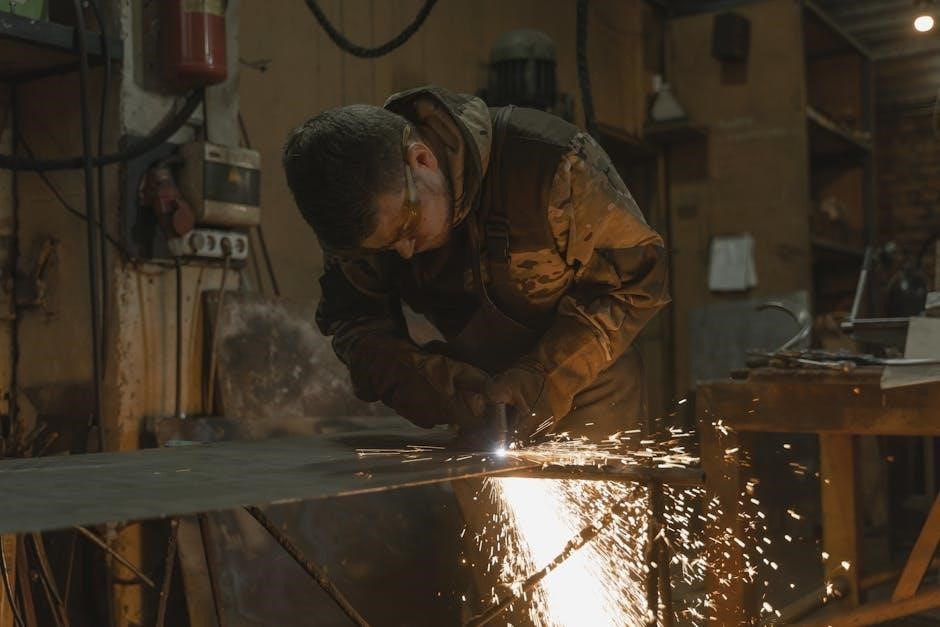
Understanding the Everlast ST Model Range
The Everlast ST model range offers a variety of stick welders, each designed with specific features and capabilities. This section provides an overview to help you identify the best model for your welding needs and applications.
Specific Models and Their Features
Explore the distinct characteristics of Everlast Stick Welder ST models, including the PowerARC 161STH and others. Each model offers unique amperage outputs, duty cycles, and features like VRD (Voltage Reduction Device). Understanding these differences is crucial for selecting the right welder for various welding tasks. Consider the specific welding applications and material types to determine the optimal model for your needs. Check the product manuals for complete details.

Safety Precautions for Operating Everlast Stick Welders
Operating Everlast stick welders safely requires strict adherence to guidelines. Always use appropriate safety gear and follow workplace safety protocols to prevent injuries. Familiarize yourself with the manual’s safety section before starting any welding task.
Essential Safety Gear
When operating Everlast stick welders, prioritizing safety is paramount. Essential safety gear includes a welding helmet with auto-darkening lens to protect your eyes from harmful arc rays. Wear fire-resistant clothing, such as a welding jacket and pants, to shield your skin from sparks and heat. Use welding gloves made of leather to protect your hands while ensuring flexibility. Safety glasses or goggles worn under the helmet provide additional eye protection. Always wear steel-toed boots to safeguard your feet from falling objects and electrical hazards. Ensure proper ventilation in your workspace to avoid inhaling fumes.
Workplace Safety Guidelines
Adhering to workplace safety guidelines is crucial when using Everlast stick welders. Ensure the welding area is clear of flammable materials and liquids. Use a fire-resistant welding blanket to contain sparks. Provide adequate ventilation to remove welding fumes and gases, or use a respirator if necessary. Inspect equipment for damage before each use, including cables and connections. Always disconnect the welder from power when not in use or during maintenance. Keep a fire extinguisher nearby and know how to use it. Never weld in damp or wet conditions to avoid electrical shock. Properly ground the welding machine and workpiece.
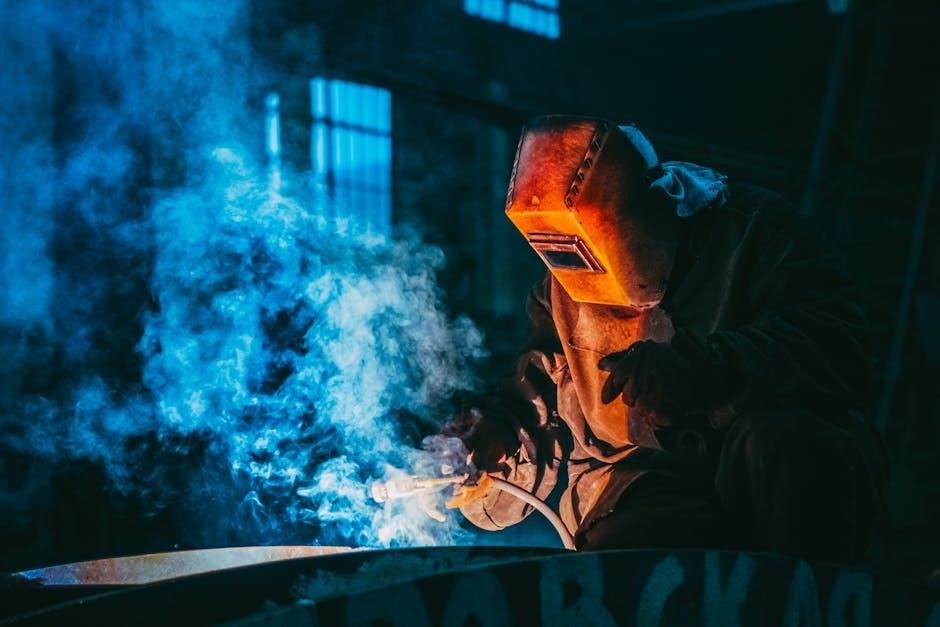
Setting Up Your Everlast Stick Welder
Proper setup is essential for optimal welding performance. This section details connecting power and ground cables and proper electrode selection. Refer to the manual for specific instructions and safety guidelines before beginning the setup process.
Connecting Power and Ground Cables
Ensuring secure and correct connections for both power and ground cables is critical for safe and effective welding. Always verify that the power source matches your welder’s requirements. Attach the ground clamp firmly to a clean, bare metal surface on the workpiece. Loose connections can cause arc instability and potential hazards. Refer to the Everlast Stick Welder ST manual for specific cable gauge recommendations and torque specifications to prevent overheating and ensure optimal conductivity.
Electrode Selection and Preparation
Choosing the right electrode is vital for achieving quality welds with your Everlast Stick Welder ST. Consider the type of metal, thickness, and desired weld characteristics. Ensure electrodes are dry and free from contaminants like moisture or rust. Select an electrode holder appropriate for the electrode size to maintain a secure grip. Consult the Everlast Stick Welder ST manual for recommended electrode types and sizes based on your specific welding application. Proper preparation ensures a stable arc and consistent weld bead.
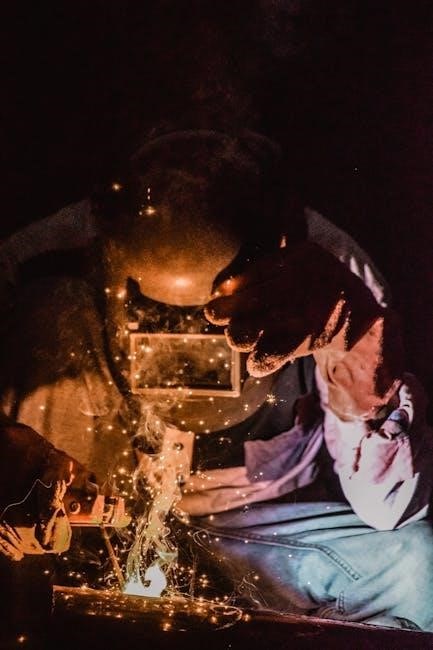
Operating Instructions for Everlast Stick Welders
This section details the proper operating procedures for Everlast Stick Welders. Learn how to adjust parameters, strike and maintain a stable arc, and achieve optimal welding results. Refer to the manual for specific model instructions.
Adjusting Welding Parameters
Properly adjusting welding parameters is crucial for achieving high-quality welds. This involves setting the amperage according to the electrode size and material thickness. Consult the Everlast Stick Welder ST manual for recommended settings. Arc force control allows you to adjust the arc characteristics for different welding positions and materials. Experiment with settings to find the optimal balance between penetration and arc stability. Always prioritize safety and wear appropriate protective gear while adjusting welding parameters. Incorrect settings can lead to poor weld quality or equipment damage.
Striking and Maintaining an Arc
Striking an arc with an Everlast stick welder requires a specific technique. Use a scratching or tapping motion to initiate the arc. Once the arc is established, maintain a consistent arc length, typically equal to the diameter of the electrode. Listen to the sound of the arc; a smooth, steady sound indicates a stable arc. Adjust your travel speed to maintain a consistent weld bead. If the electrode sticks, use a quick twisting motion to break it free. Practice to develop a steady hand and consistent arc control, referencing the manual as needed.
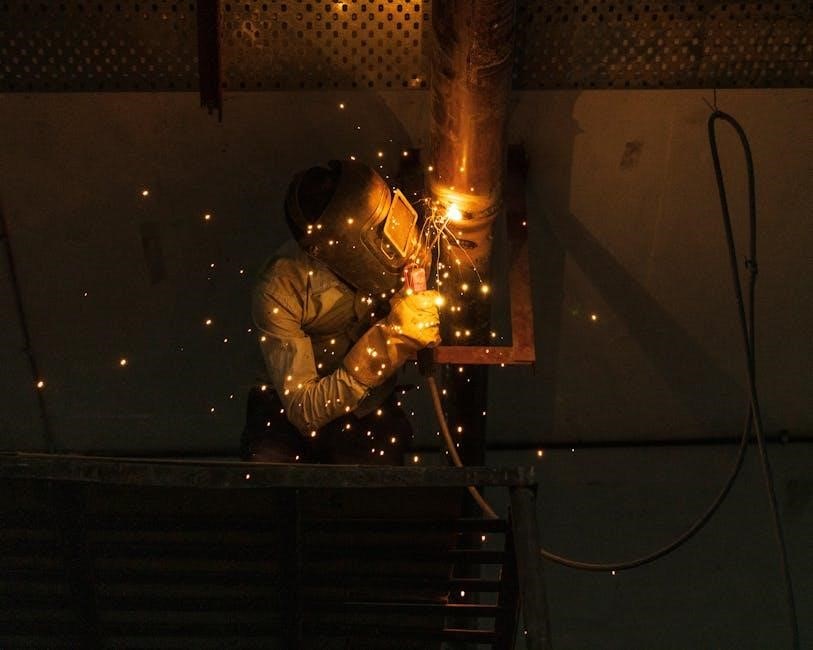
Troubleshooting Common Issues
This section addresses common problems encountered while using Everlast stick welders. It covers issues like arc instability and electrode sticking, providing diagnostic steps and solutions. Refer to this section for quick fixes and preventative measures to ensure smooth operation.
Arc Instability
Arc instability in Everlast stick welders can stem from various factors. Common causes include improper amperage settings, incorrect electrode selection, or issues with the grounding connection. Contaminated base materials, excessive rust, or paint can also disrupt the arc. Ensure the welding area is clean and the ground clamp is securely attached to a clean metal surface. Adjusting the amperage within the recommended range for the chosen electrode may also resolve the issue. If problems persist, inspect the electrode holder for damage or loose connections.
Electrode Sticking
Electrode sticking is a common problem with Everlast stick welders, usually caused by insufficient amperage or improper technique. If the electrode sticks to the workpiece, increase the amperage setting gradually until a stable arc is achieved. Maintaining a consistent arc length and avoiding excessive pressure on the electrode can also prevent sticking. Ensure the electrode is appropriate for the material being welded and that the surface is clean. A dragging technique or moving too slowly can cause sticking; adjust your speed accordingly. Also, verify that the polarity is correct for the electrode.
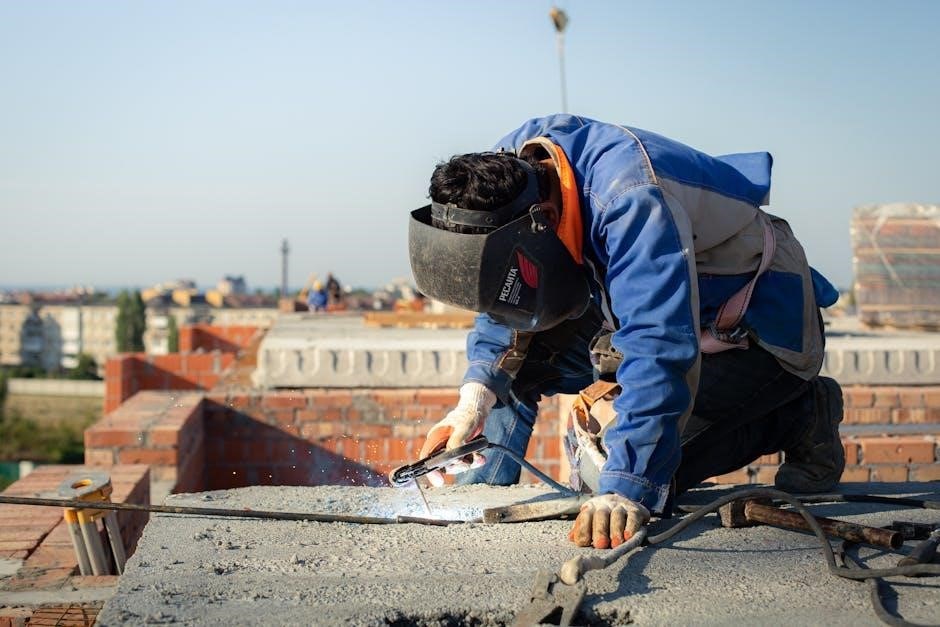
Maintenance and Care of Your Everlast Stick Welder
Proper maintenance ensures your Everlast stick welder’s longevity and optimal performance. Regular cleaning, inspection, and timely replacement of worn parts are crucial. Following these guidelines will keep your welder in top condition, reducing downtime and ensuring consistent welding results.
Regular Cleaning Procedures
To maintain your Everlast stick welder, regular cleaning is essential. Begin by disconnecting the power source. Use compressed air to remove dust and debris from the machine’s exterior and interior components. Pay close attention to vents and electrical connections. Wipe down the casing with a clean, dry cloth. Inspect cables for damage and replace if necessary. Clean the electrode holder regularly to ensure good contact. Proper cleaning prevents overheating and extends the welder’s lifespan. Avoid using liquids that could cause short circuits;
Inspection and Replacement of Parts
Regular inspection of your Everlast stick welder’s components is crucial for maintaining optimal performance; Check cables for fraying or damage, replacing them as needed to prevent electrical hazards. Inspect the electrode holder for wear and tear, ensuring secure electrode connections. Examine the ground clamp for corrosion or damage, cleaning or replacing it to maintain a solid ground. Periodically inspect internal components for signs of overheating or wear. Replace any worn or damaged parts promptly to avoid further damage and ensure safe operation. Refer to the manual for specific part numbers and replacement procedures.
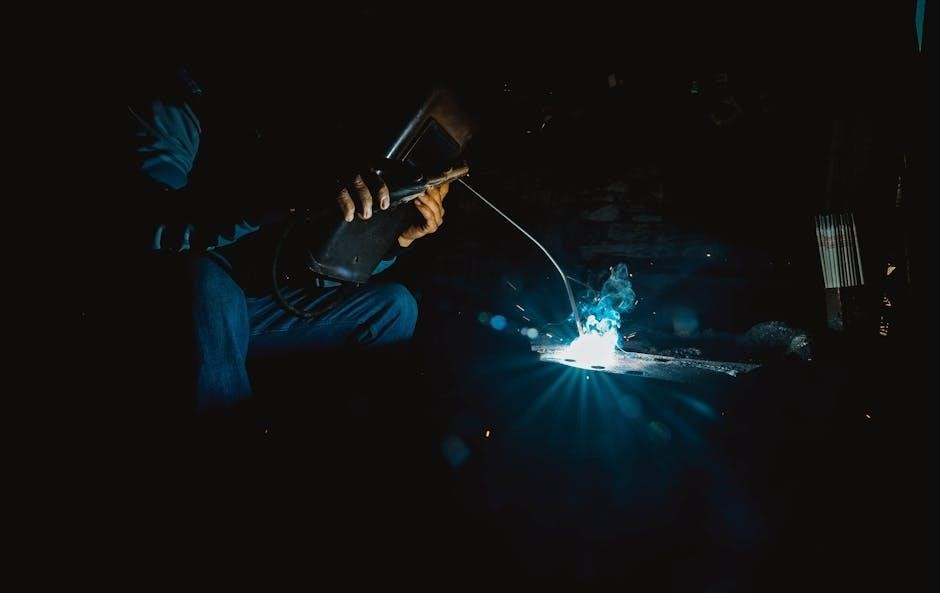
Advanced Techniques and Applications
Explore advanced welding techniques using your Everlast stick welder, including welding different materials and project-specific applications. Master specialized methods to enhance weld quality and broaden your welding capabilities for diverse projects and materials.
Welding Different Materials
Everlast stick welders offer versatility for joining various metals. When welding steel, select the appropriate electrode type, such as E6011 or E7018, based on the steel’s thickness and desired weld characteristics. For stainless steel, use electrodes like E308 or E316 to prevent corrosion and maintain strength. Welding cast iron requires specialized nickel-based electrodes to avoid cracking. Adjust amperage and technique for each material to achieve optimal fusion and prevent defects. Always consult material-specific welding guides.
Specific Project Applications
Everlast stick welders are ideal for diverse projects. They are well-suited for repair work, such as fixing farm equipment or automotive components, thanks to their portability and ability to weld in various positions. Construction projects benefit from stick welding’s robust welds for structural steel. DIY enthusiasts can use stick welders for creating metal art, fabricating furniture, or building custom frames. Always ensure proper safety measures and select appropriate electrodes for each application. Consult project-specific guidelines to achieve desired outcomes.

Everlast Stick Welder Manual: Key Features and Navigation
Understanding your Everlast Stick Welder manual is crucial. Key features include detailed diagrams, troubleshooting guides, and safety protocols. Efficient navigation ensures quick access to essential information for optimal welder operation and maintenance.
Understanding the Manual’s Structure
The Everlast Stick Welder ST manual is structured to provide a clear and concise understanding of the equipment. It begins with safety guidelines, followed by setup instructions, operating procedures, and troubleshooting tips. Diagrams and illustrations are included for visual clarity. Sections on maintenance and advanced techniques are also present. The manual aims to guide users through every aspect of welder operation. Specific models and features are detailed for the PowerTIG 185 DV and 255 EXT, with comprehensive information on adjustments and settings.
Accessing Digital Manuals and Support
Digital manuals for Everlast Stick Welders are readily accessible online through the Everlast Power Equipment website. These manuals are available for download in PDF format, offering a convenient way to access information on safety, setup, and operation. Additionally, Everlast provides AI chat support for instant answers to common questions and concerns. Users can also find support through welding forums and communities, where they can share experiences and seek advice from other welders. Specific manuals are available for models like the PowerTIG 200DX and PowerMTS 211S.

Where to Find Additional Support and Resources
Find extra support for Everlast Stick Welders via Everlast’s website and support channels. Explore welding forums and communities for shared experiences. Contact Everlast directly for specific settings, welding applications, and issue resolution assistance by email or phone.
Everlast’s Website and Support Channels
The Everlast website offers a wealth of resources, including product manuals, specifications, and troubleshooting guides for stick welders. Customers can access support channels such as phone, email, and online forums to get assistance with technical issues, welding guidance, and general inquiries. Everlast’s support team can aid in diagnosing issues, providing specific settings, and addressing concerns related to welding applications. They offer comprehensive assistance to ensure users have the best experience.
Welding Forums and Communities
Online welding forums and communities offer a valuable platform for Everlast stick welder users to connect, share knowledge, and seek advice. These forums provide a space for discussing specific welding techniques, troubleshooting common issues, and exchanging tips on machine maintenance. Users can benefit from the collective experience of fellow welders, gaining insights into optimal settings, electrode selection, and project-specific applications. Active participation in these communities can significantly enhance a welder’s skills and problem-solving abilities, fostering a collaborative learning environment.
